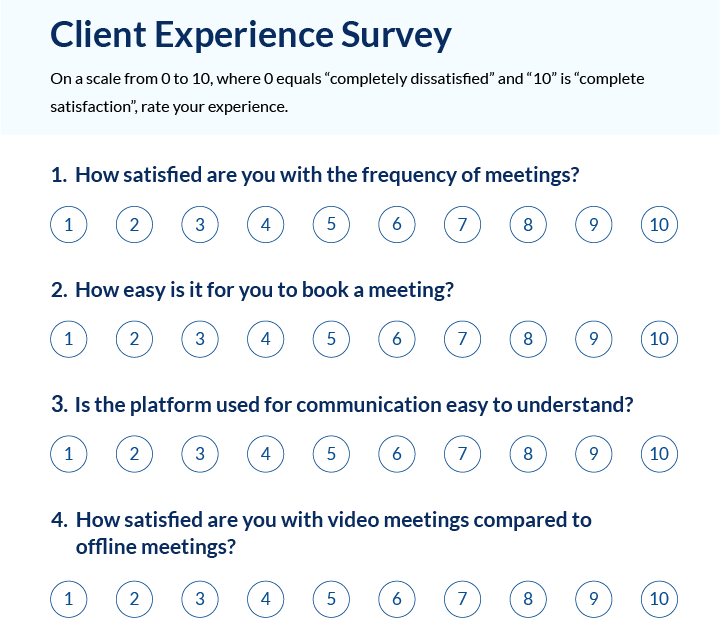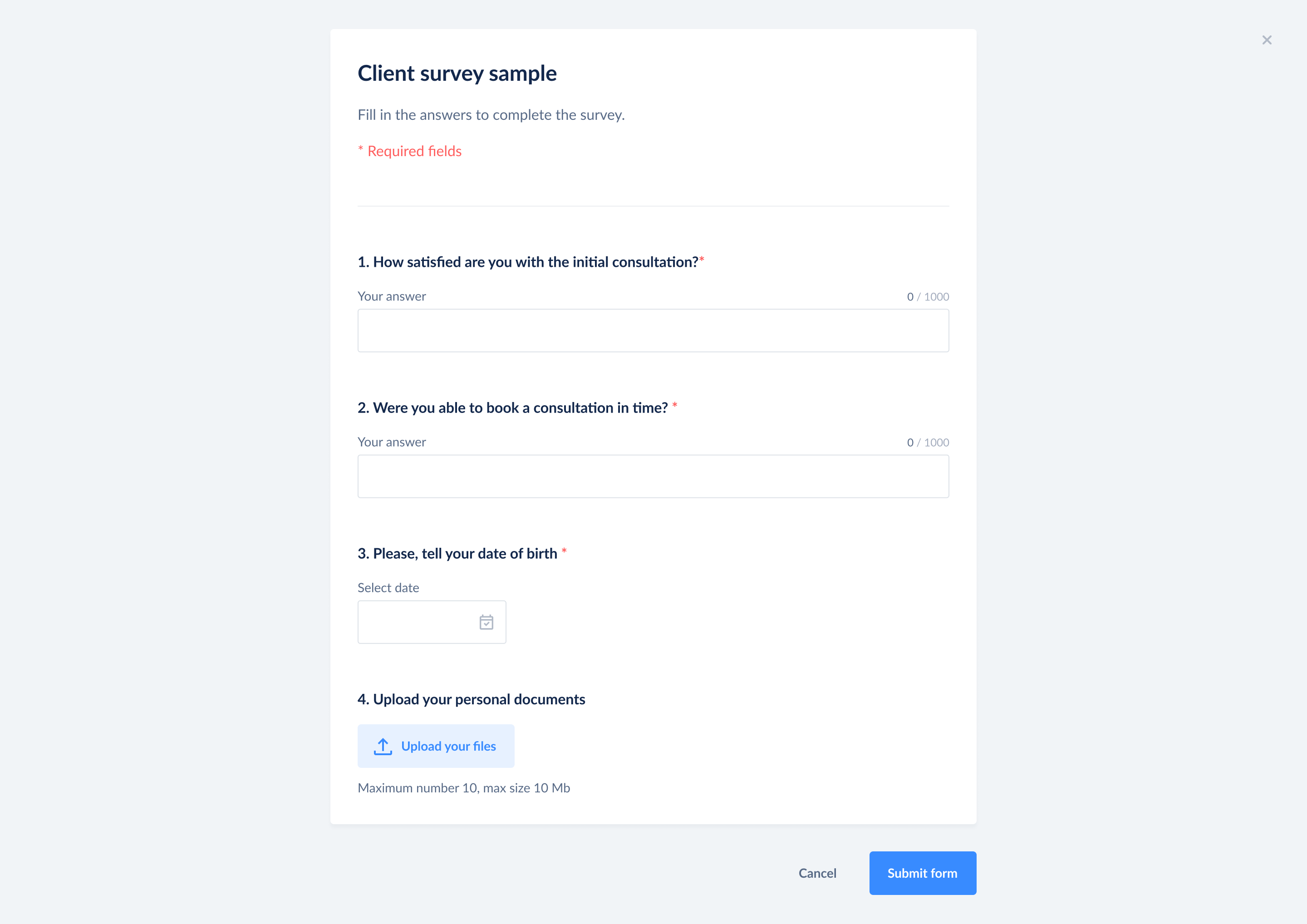An effective financial advisor client survey can give you insights into your clients' expectations and help you improve your services. When you implement surveys as part of your strategy for communicating with clients, you will start to gather the information that you can use to increase client retention and get more referrals. If you haven’t implemented client surveys yet, it’s the right time to add them to your workflow. Keep reading to learn about:
- why you should run client surveys
- the major types of client surveys
- how to create an effective client survey
You will also get useful tips and insights that will assist you in forming questions, along with a financial advisor client questionnaire that you can use.
Why financial advisor client surveys are essential
Many people assume that implementing client surveys isn’t vital. Some think that it’s to early to run them when they’re at the start of their career. There are also people, who have been in a business for a long time and don’t believe in holding surveys as well. However, surveys can provide you with many valuable insights you can use to strengthen your business regardless of your experience level. Let’s take a close look at the main advantages of holding regular client surveys:
- Get valuable feedback. With properly formed questions, you can learn how clients perceive your services and learn about clients’ needs.
- Discover areas for improvement. Even if you already know what your clients need, surveys are helpful when you have to prioritize what to improve next.
- Better understand your clients. As you study how your clients have learned about you and what made them contact you, you get a better understanding of effective client acquisition methods.
- Obtain insights into trends. Surveys can make you aware of upcoming trends and new services your clients might look for in the future.
- Increase client retention. Though holding regular surveys isn’t enough to grow retention, implementing the improvements suggested by your clients will make them feel like you go that extra mile.
- Strengthen loyalty and brand advocacy. When your clients are satisfied, they’re more likely to stick with you and refer others to you.
Moreover, using client surveys will help you identify what makes some of your clients unhappy so you can avoid such scenarios if possible.
According to Glance, 70% of unhappy clients whose problems are resolved are willing to do business again.
You can’t underestimate the impact of running client surveys. However, you still need to make sure the surveys you run provide you with accurate data and that the type of survey you’ve chosen fits your goals. Otherwise, the data might turn out useless for you. Keep reading to learn what types of client surveys you can run.
Types of client survey scores for financial advisors
One of the most common categorizations divides client survey scores into three types depending on the goal they pursue. Let’s overview each type of client survey score and learn when you will benefit from using it.
Customer Satisfaction Score (CSAT)
A Customer Satisfaction Score (CSAT) survey lets you evaluate client satisfaction by asking your clients straightforward yes/no questions or asking them to rate their experience on a scale.
You can implement CSAT surveys in many ways, using forms, pop-ups, or a chatbot. Just make sure the survey is easy to access and doesn’t take long to complete.
Check out the following financial advisor client survey questions:

The more precise the questions in your CSAT survey, the better.
Net Promoter Score (NPS)
A Net Promoter Score (NPS) survey can be used to estimate how likely your clients are to provide a referral and recommend your services (and you personally as a financial specialist). A Net Promoter Score uses a scale from 0 to 10. After getting the results, you will need to use the formula below to calculate your NPS:

The questions in an NPS survey often specify a group of people to whom your client might recommend your services.
Here is an example of an NPS survey question:
How likely are you to recommend [X services] to a colleague?
A Net Promoter Score will provide you with insights into the satisfaction of active clients and will help you measure client loyalty.
Customer Effort Score (CES)
The Customer Effort Score (CES) highlights difficulties your clients might face when using your services.
The questions in a CES survey should be designed to let your clients rate how easy it is for them to work with you or use your services, from very easy to very difficult.
Here is an example of a CES survey question:
How easy was it to book a consultation?
Note that the questions you ask will depend on the aspects of your services or processes you want to evaluate. For example, the question above might help you learn that your clients struggle to find free time slots. When the actions essential for a satisfactory client experience take lots of effort, you’ll likely have a higher churn rate (the rate that shows how many customers you lose on average, compared to acquisition).
How to create a client survey
Now that you know what types of client surveys you can run, it’s time to create one. Use the eight powerful tips below to build a survey that will help you assess possible issues, determine client satisfaction rates, and learn about your clients’ experience.
#1 Set a survey goal
Setting a realistic goal for your financial advisor client survey makes a huge difference. Without understanding the purpose of your survey, you won’t be able to ask the right questions, and the results might lead you nowhere.
Ensure the goal you’ve chosen:
- represents your primary aim
- explains what you’re looking for
- broadly covers one specific area you’re interested in investigating
After setting a goal, you can add survey objectives that represent the steps to achieve your goal.
#2 Make sure your survey results can be applied in practice
The next tip is to ensure the results you get will help you find the answers you’re looking for. There are a few rules you must follow to avoid falling into the trap of inconsistent, ambiguous questions.
Keep the survey short and focused
Refrain from adding questions that aren’t strictly related to your survey’s goal and objectives. In particular, stay away from questions that won’t directly provide the data you need. The fewer questions you have, the more attention you’ll be able to get from your clients.
SurveyMonkey research reveals that a successful survey takes five minutes or less to complete. After five minutes, participants tend to abandon a survey.
Keep your questions simple
Sometimes, financial advisors overcomplicate questions or use terminology that confuses respondents. As a result, the data collected is inconsistent because respondents don’t understand the questions clearly. The most common mistakes are:
- asking a leading question (one that suggests a certain answer)
- using loaded questions that assume something that is yet to be confirmed
- adding questions that encourage respondents to prove your point
- using acronyms or terms unknown to your respondents
- being too general
You can see two examples of survey questions below. One of them is specific and straightforward, while the other is vague.

Use closed-ended questions whenever possible
If you can replace a question that requires a detailed response with a yes/no question, do it. Alternatively, use multiple-choice questions or ask for a rating as a response. This way, the data you collect will be easier to analyze and apply in practice.
Keep the rating scale consistent throughout the survey
To get consistent data, use the same rating scale for all questions in a given survey. This will increase the trustworthiness of your results by avoiding unintentional responses due to potential confusion.
#3 Structure the survey
Another helpful tip is to carefully structure the questions. This will prevent your respondents from losing track of their thoughts or failing to answer the most important questions because they leave the survey before it's finished. To structure a survey, follow these recommendations:
- Give your survey a clear title that reflects the topic of your questions.
- Add detailed instructions that will help respondents understand what you want them to do (e.g., rate their experience using a certain scale).
- Avoid causing any discomfort with your choice of questions or words.
- Ask the most important questions at the beginning and the least important at the end.
- If you have to add a difficult question that will require some time to answer, place it at the very end.
- Group questions that are related to the same topic.
Here is an example of a financial advisor client questionnaire that can be used to score client satisfaction.

It is structured to get a measurable client satisfaction score and consists of several logical blocks.
Feel free to download a financial advisor client questionnaire that you can use as a template or as inspiration to create your own.
#4 Test your survey
Before launching a survey, test it to ensure there aren’t any unclear questions. Testing will also help you avoid possible misinterpretations. You can ask your colleagues to answer the questions, or reach out to several members of your target audience and see if they have any difficulties.
#5 Consider your audience when sending survey invitations
One of the most common mistakes is to include questions your respondents aren’t able to answer. For example, it’s not the best idea to add a question about invoices when only some of your clients need invoices. This will lead to receiving irrelevant data.
Ensure that those you survey can answer your questions.
#6 Consider sending a few reminders
There’s a thin line between reminding your clients to answer a questionnaire and being annoying. However, you can still send a second reminder if you think it’s appropriate. In fact, sending reminders to people who haven't answered your questionnaire often boosts the response rate.
#7 Consider offering an incentive
There are many ways to encourage clients to participate in your survey. You can offer a checklist or a whitepaper that contains unique information, or you can provide a discount for some of your services. Just make sure that you don’t use this encouragement to get positive feedback. Your incentives shouldn’t affect your respondents’ opinions. If they do, the survey will be biased.
#8 Use proper software
The software you use to collect responses is one of the key factors that affects the response rate. If the software is too complicated to use or your clients have to switch to another platform to take the survey, most likely you’ll have fewer responses than you expected.
Moreover, the software you choose has to provide you with the means to collect data that fits the form of your survey.
For example, consider how the ExpertBox all-on-one platform can help you hold surveys.
If you’re interested in getting clients to fill out an intake form with questions that will let you better prepare for a consultation and highlight client expectations, you can use the ExpertBox Intake forms tool.
As you set up the form and add questions to it, you can specify when you want to send this form to a client.
After everything is set up, your clients will receive this form (or even several forms) when they book a service or before an appointment. The ExpertBox interface will ask them to proceed to your intake form right from their account, so the chances your form will be unnoticed are slim.

With ExpertBox, you can also collect client feedback after a consultation or another type of meeting. Use a feedback collection form to ensure customer satisfaction.

The ExpertBox platform also lets you send a questionnaire file to your client as one of the documents they need to complete before or after the consultation. This way, you can hold even the most detailed surveys that consist of complex scales.
Get a 14-day ExpertBox trial to use ExpertBox for client scheduling, client relationship management, online communication, and holding surveys.
For more advanced financial advisor client surveys, you can use specialized tools like JotForm and SurveyMonkey that offer options to work on surveys as a team and provide survey templates. However, you will still have to take your time to adjust them to your specific goals and questions.
Wrapping up
Getting to know the mind of your client is essential if you’re looking for ways to improve the client experience and grow retention. Use client surveys to build meaningful relationships with your clients and discover their needs. Subscribe to our newsletter to learn more about building client relationships and nurturing your financial advisory business.
FAQ
-
One of the most common categorizations divides client surveys into three types based on the score they are focused on obtaining:
- The Customer Satisfaction Score (CSAT) lets you evaluate client satisfaction by asking your clients straightforward questions and offering them to rate their experience on a scale.
- The Net Promoter Score (NPS) can be used to estimate how likely your client is to provide a referral and recommend your services (and you personally as a financial advisor).
- The Customer Effort Score (CES) highlights difficulties your clients might face when using your services.
-
Use the eight powerful tips below to build a survey that will help you assess possible issues, calculate client satisfaction rates, and learn about your clients’ experience:
- Set a survey goal
- Make your survey results applicable in practice
- Structure the survey
- Test your survey questions
- Consider your audience
- Remind participants to complete the survey
- Offer an incentive
- Use proper software
-
Feel free to download a financial advisor client questionnaire that you can use as a template or as inspiration to create your own.




